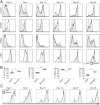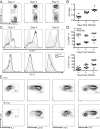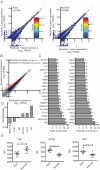Rapid proliferation and differentiation impairs the development of memory CD8+ T cells in early life
- PMID: 24850719
- PMCID: PMC4065808
- DOI: 10.4049/jimmunol.1400553
Rapid proliferation and differentiation impairs the development of memory CD8+ T cells in early life
Abstract
Neonates often generate incomplete immunity against intracellular pathogens, although the mechanism of this defect is poorly understood. An important question is whether the impaired development of memory CD8+ T cells in neonates is due to an immature priming environment or lymphocyte-intrinsic defects. In this article, we show that neonatal and adult CD8+ T cells adopted different fates when responding to equal amounts of stimulation in the same host. Whereas adult CD8+ T cells differentiated into a heterogeneous pool of effector and memory cells, neonatal CD8+ T cells preferentially gave rise to short-lived effector cells and exhibited a distinct gene expression profile. Surprisingly, impaired neonatal memory formation was not due to a lack of responsiveness, but instead because neonatal CD8+ T cells expanded more rapidly than adult cells and quickly became terminally differentiated. Collectively, these findings demonstrate that neonatal CD8+ T cells exhibit an imbalance in effector and memory CD8+ T cell differentiation, which impairs the formation of memory CD8+ T cells in early life.
Copyright © 2014 by The American Association of Immunologists, Inc.
Figures






References
-
- Siegrist CA. Neonatal and early life vaccinology. Vaccine. 2001;19:3331–3346. - PubMed
-
- Adkins B, Leclerc C, Marshall-Clarke S. Neonatal adaptive immunity comes of age. Nat Rev Immunol. 2004;4:553–564. - PubMed
-
- Chang J, Braciale TJ. Respiratory syncytial virus infection suppresses lung CD8+ T-cell effector activity and peripheral CD8+ T-cell memory in the respiratory tract. Nat Med. 2002;8:54–60. - PubMed
-
- Zinkernagel RM, Doherty PC. Immunological surveillance against altered self components by sensitised T lymphocytes in lymphocytic choriomeningitis. Nature. 1974;251:547–548. - PubMed
Publication types
MeSH terms
Grants and funding
LinkOut - more resources
Full Text Sources
Other Literature Sources
Molecular Biology Databases
Research Materials

